Spatial Association Rules and Thermal Environment Differentiation Evaluation of Local Climate Zone and Urban Functional Zone
Abstract
:1. Introduction
2. Study Area and Data Collection
2.1. Study Area
2.2. Data Sources
3. Method
3.1. Local Climate Zones (LCZs) Classification
3.2. LCZ and UFZ Association Rule Mining
- (1)
- Overlay analysis was conducted by calculating the spatial overlap of the two systems. The urban function classification results of different systems were spatially superimposed. As shown in Figure 4, a local climate zone (LCZ1) intersects several functional zones (UFZa and UFZb). Their spatial overlap area can be expressed as LCZ1 ∩ UFZa and LCZ1 ∩ UFZb. The spatial correlation degree (SCD) of UFZa in the functional area to LCZ1 was calculated as follows: SCD (LCZ1|UFZa) = (LCZ1 ∩ UFZa)/UFZa (i.e., 100% in Figure 4). The SCD of LCZ1 to UFZa was calculated as follows: SCD (UFZa|LCZ1) = LCZ1 ∩ UFZa/LCZ1 (i.e., 40% in Figure 4).
- (2)
- Ranking the correlation degrees: a correlation degree of 70–100% is high; 30–70% is medium; and less than 30% is low.
- (3)
- According to the above two steps, we obtained the results regarding the degree of correlation of each block with other types of blocks. We filtered out all blocks with high correlation degrees, and used Apriori algorithm to mine the association rules of UFZ and LCZ.
3.3. Land Surface Temperature Retrieval
3.4. Geographic Detector Analysis
4. Results and Discussion
4.1. LCZ Classification Results
4.2. Surface Temperature Distribution
4.3. Association Rule Mining Results
4.4. Analysis of Thermal Environment Differentiation between UFZ and LCZ
5. Conclusions
Author Contributions
Funding
Data Availability Statement
Conflicts of Interest
References
- World Meteorological Organization. State of the Global Climate 2021 (WMO-No. 1290). 2022. Available online: https://library.wmo.int/doc_num.php?explnum_id=11178 (accessed on 18 August 2023).
- Georgescu, M.; Moustaoui, M.; Mahalov, A.; Dudhia, J. Summer-time climate impacts of projected megapolitan expansion in Arizona. Nat. Clim. Change 2012, 3, 37–41. [Google Scholar] [CrossRef]
- Yang, L.; Li, X.; Shang, B. Impacts of Urban Expansion on the Urban Thermal Environment: A Case Study of Changchun, China. Chin. Geogr. Sci. 2022, 32, 79–92. [Google Scholar] [CrossRef]
- Guhathakurta, S.; Gober, P. The impact of the phoenix urban heat island on residential water use. J. Am. Plan. Assoc. 2007, 73, 317–329. [Google Scholar] [CrossRef]
- Li, J.; Song, C.; Cao, L.; Zhu, F.; Meng, X.; Wu, J. Impacts of landscape structure on surface urban heat islands: A case study of Shanghai, China. Remote Sens. Environ. 2011, 115, 3249–3263. [Google Scholar] [CrossRef]
- Du, H.; Zhou, F.; Li, C.; Cai, W.; Jiang, H.; Cai, Y. Analysis of the Impact of Land Use on Spatiotemporal Patterns of Surface Urban Heat Island in Rapid Urbanization, a Case Study of Shanghai, China. Sustainability 2020, 12, 1171. [Google Scholar] [CrossRef]
- Liu, Y.; Peng, J.; Wang, Y. Efficiency of landscape metrics characterizing urban land surface temperature. Landsc. Urban Plan. 2018, 180, 36–53. [Google Scholar] [CrossRef]
- Li, Y.-y.; Liu, Y.; Ranagalage, M.; Zhang, H.; Zhou, R. Examining Land Use/Land Cover Change and the Summertime Surface Urban Heat Island Effect in Fast-Growing Greater Hefei, China: Implications for Sustainable Land Development. ISPRS Int. J. Geo-Inf. 2020, 9, 568. [Google Scholar] [CrossRef]
- Guo, G.; Zhou, X.; Wu, Z.; Xiao, R.; Chen, Y. Characterizing the impact of urban morphology heterogeneity on land surface temperature in Guangzhou, China. Environ. Model. Softw. 2016, 84, 427–439. [Google Scholar] [CrossRef]
- Zhang, Q.; Wu, Z.; Singh, V.P.; Liu, C. Impacts of Spatial Configuration of Land Surface Features on Land Surface Temperature across Urban Agglomerations, China. Remote Sens. 2021, 13, 4008. [Google Scholar] [CrossRef]
- Wang, Y.; Zhan, Q.; Ouyang, W. How to quantify the relationship between spatial distribution of urban waterbodies and land surface temperature? Sci. Total Environ. 2019, 671, 1–9. [Google Scholar] [CrossRef]
- Yin, C.; Man, Y.; Lu, Y.; Huang, Y.; Liu, Y. Effects of urban form on the urban heat island effect based on spatial regression model. Sci. Total Environ. 2018, 634, 696–704. [Google Scholar] [CrossRef]
- Zhao, C.H.; Jensen, J.; Weng, Q.H.; Weaver, R. A Geographically Weighted Regression Analysis of the Underlying Factors Related to the Surface Urban Heat Island Phenomenon. Remote Sens. 2018, 10, 1428. [Google Scholar] [CrossRef]
- Hamid, T.S.; Sahar, S.; Abbas, E.Z.; Tarek, A.; Hesham, A.; Kristin, K. A Comprehensive Statistical Study on Daytime Surface Urban Heat Island during Summer in Urban Areas, Case Study: Cairo and Its New Towns. Remote Sens. 2016, 8, 643. [Google Scholar]
- Huang, G.; Cadenasso, M.L. People, landscape, and urban heat island: Dynamics among neighborhood social conditions, land cover and surface temperatures. Landsc. Ecol. 2016, 31, 2507–2515. [Google Scholar] [CrossRef]
- Li, K.; Chen, Y.; Gao, S. Comparative Analysis of Variations and Patterns between Surface Urban Heat Island Intensity and Frequency across 305 Chinese Cities. Remote Sens 2021, 13, 3505. [Google Scholar] [CrossRef]
- Wong, K.V.; Dai, Y.; Paul, B. Anthropogenic Heat Release into the Environment. J. Energy Resour. Technol. 2012, 134, 041602. [Google Scholar] [CrossRef]
- Taha, H. Urban climates and heat islands: Albedo, evapotranspiration, and anthropogenic heat. Energ Build. 1997, 25, 99–103. [Google Scholar] [CrossRef]
- Feng, Y.; Du, S.; Myint, S.W.; Shu, M. Do Urban Functional Zones Affect Land Surface Temperature Differently? A Case Study of Beijing, China. Remote Sens. 2019, 11, 1802. [Google Scholar] [CrossRef]
- Lee, S.H.; Song, C.K.; Baik, J.J.; Park, S.U. Estimation of anthropogenic heat emission in the Gyeong-In region of Korea. Theor. Appl. Climatol. 2009, 96, 291–303. [Google Scholar] [CrossRef]
- Stewart, I.D.; Oke, T.R. Local climate zones for urban temperature studies. Bull. Am. Meteorol. Soc. 2012, 93, 1879–1900. [Google Scholar] [CrossRef]
- Bechtel, B.; Alexander, P.J.; Böhner, J.; Ching, J.; Conrad, O.; Feddema, J.; Mills, G.; See, L.; Stewart, I. Mapping Local Climate Zones for a Worldwide Database of the Form and Function of Cities. ISPRS Int. J. Geo-Inf. 2015, 4, 199–219. [Google Scholar] [CrossRef]
- Shi, L.; Ling, F. Local Climate Zone Mapping Using Multi-Source Free Available Datasets on Google Earth Engine Platform. Land 2021, 10, 454. [Google Scholar] [CrossRef]
- Jiang, R.; Xie, C.; Man, Z.; Zhou, R.; Che, S. Effects of Urban Green and Blue Space on the Diffusion Range of PM2.5 and PM10 Based on LCZ. Land 2023, 12, 964. [Google Scholar] [CrossRef]
- Yang, J.; Ren, J.Y.; Sun, D.Q.; Xiao, X.M.; Xia, J.; Jin, C.; Li, X.M. Understanding land surface temperature impact factors based on local climate zones. Sustain. Cities Soc. 2021, 69, 102818. [Google Scholar] [CrossRef]
- Xu, Y.; Zhang, C.; Hou, W. Modeling of Daytime and Nighttime Surface Urban Heat Island Distribution Combined with LCZ in Beijing, China. Land 2022, 11, 2050. [Google Scholar] [CrossRef]
- Cai, M.; Ren, C.; Xu, Y. Investigating the relationship between Local Climate Zone and land surface temperature. In Proceedings of the 2017 Joint Urban Remote Sensing Event (JURSE), Dubai, United Arab Emirates, 6–8 March 2017; pp. 1–4. [Google Scholar]
- Quanz, J.A.; Ulrich, S.; Fenner, D.; Holtmann, A.; Eimermacher, J. Micro-Scale Variability of Air Temperature within a Local Climate Zone in Berlin, Germany, during Summer. Climate 2018, 6, 5. [Google Scholar] [CrossRef]
- Kwok, Y.T.; Schoetter, R.; Lau, K.K.L.; Hidalgo, J.; Ren, C.; Pigeon, G.; Masson, V. How well does the local climate zone scheme discern the thermal environment of Toulouse (France)? An analysis using numerical simulation data. Int. J. Climatol. 2019, 39, 5292–5315. [Google Scholar] [CrossRef]
- Jga, B.; Ml, C.; Ss, D.; Dm, D. Inter-/intra-zonal seasonal variability of the surface urban heat island based on local climate zones in three central European cities. Build. Environ. 2019, 156, 21–32. [Google Scholar]
- Gong, P.; Chen, B.; Li, X.; Liu, H.; Wang, J.; Bai, Y.; Chen, J.; Chen, X.; Fang, L.; Feng, S.; et al. Mapping essential urban land use categories in China (EULUC-China): Preliminary results for 2018—ScienceDirect. Sci. Bull. 2020, 65, 182–187. [Google Scholar] [CrossRef]
- Zhang, Z.; Qian, Z.; Zhong, T.; Chen, M.; Zhang, K.; Yang, Y.; Zhu, R.; Zhang, F.; Zhang, H.; Zhou, F.; et al. Vectorized rooftop area data for 90 cities in China. Sci. Data 2022, 9, 66. [Google Scholar] [CrossRef] [PubMed]
- Woodworth, M.D. Planning for Growth: Urban and Regional Planning in China. Int. J. Urban Reg. 2018, 42, 539–541. [Google Scholar] [CrossRef]
- Dissanayake, D.; Morimoto, T.; Murayama, Y.; Ranagalage, M. Impact of Landscape Structure on the Variation of Land Surface Temperature in Sub-Saharan Region: A Case Study of Addis Ababa using Landsat Data (1986–2016). Sustainability 2019, 11, 2257. [Google Scholar] [CrossRef]
- Papi, R.; Attarchi, S.; Darvishi Boloorani, A.; Neysani Samany, N. Knowledge discovery of Middle East dust sources using Apriori spatial data mining algorithm. Ecol. Inform. 2022, 72, 101867. [Google Scholar] [CrossRef]
- Gillespie, A.; Rokugawa, S.; Matsunaga, T.; Cothern, J.S.; Hook, S.; Kahle, A.B. A temperature and emissivity separation algorithm for Advanced Spaceborne Thermal Emission and Reflection Radiometer (ASTER) images. IEEE Trans. Geosci. Remote Sens. 1998, 36, 1113–1126. [Google Scholar] [CrossRef]
- Qin, Z.; Li, W.; Gao, M.; Zhang, H. Estimation of land surface emissivity for Landsat TM6 and its application to Lingxian Region in north China. In Proceedings of the SPIE—The International Society for Optical Engineering, Shanghai, China, 2006. [Google Scholar]
- Wang, J.F.; Zhang, T.L.; Fu, B.J. A measure of spatial stratified heterogeneity. Ecol. Indic. 2016, 67, 250–256. [Google Scholar] [CrossRef]
- Wang, J.F.; Xu, J.D. Geodetector: Principle and prospective. Acta Geogr. Sin. 2017, 72, 116–134. [Google Scholar]
- Xi, C.; Ren, C.; Wang, J.Q.; Feng, Z.B.; Cao, S.J. Impacts of urban-scale building height diversity on urban climates: A case study of Nanjing, China. Energy Build. 2021, 251, 111350. [Google Scholar] [CrossRef]
- Zhang, X.; Zhong, T.Y.; Feng, X.Z.; Wang, K. Estimation of the relationship between vegetation patches and urban land surface temperature with remote sensing. Int. J. Remote Sens. 2009, 30, 2105–2118. [Google Scholar] [CrossRef]


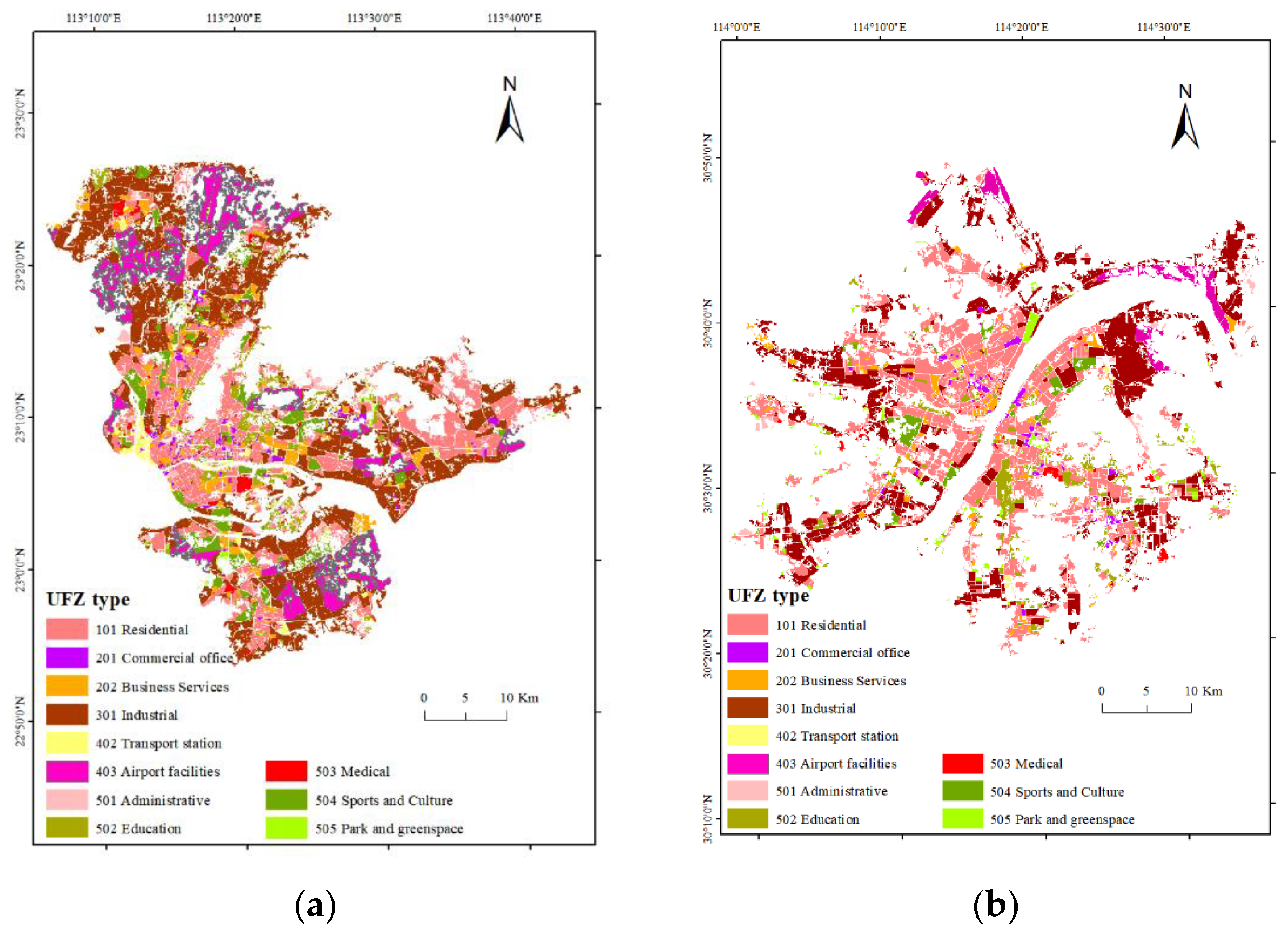


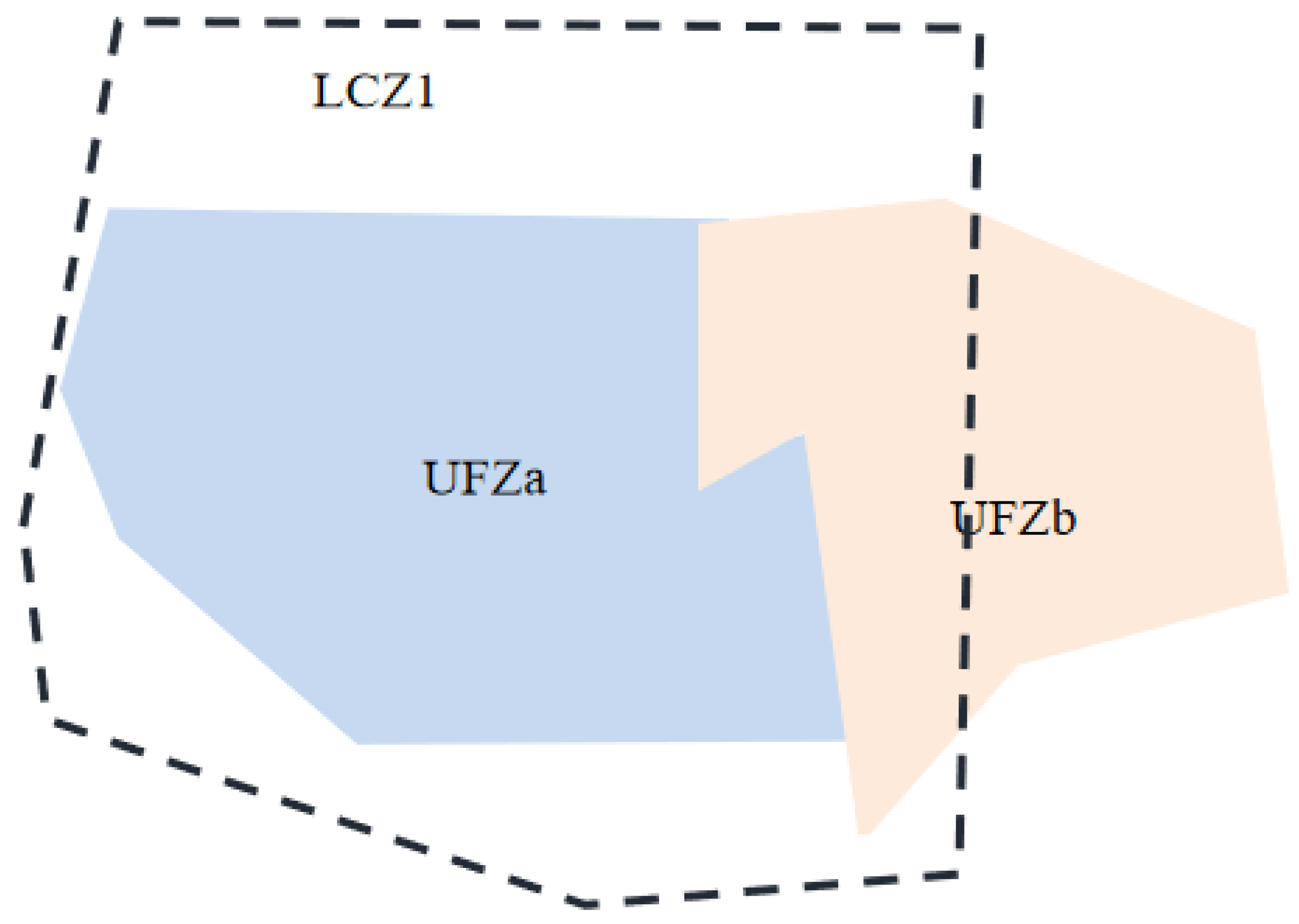
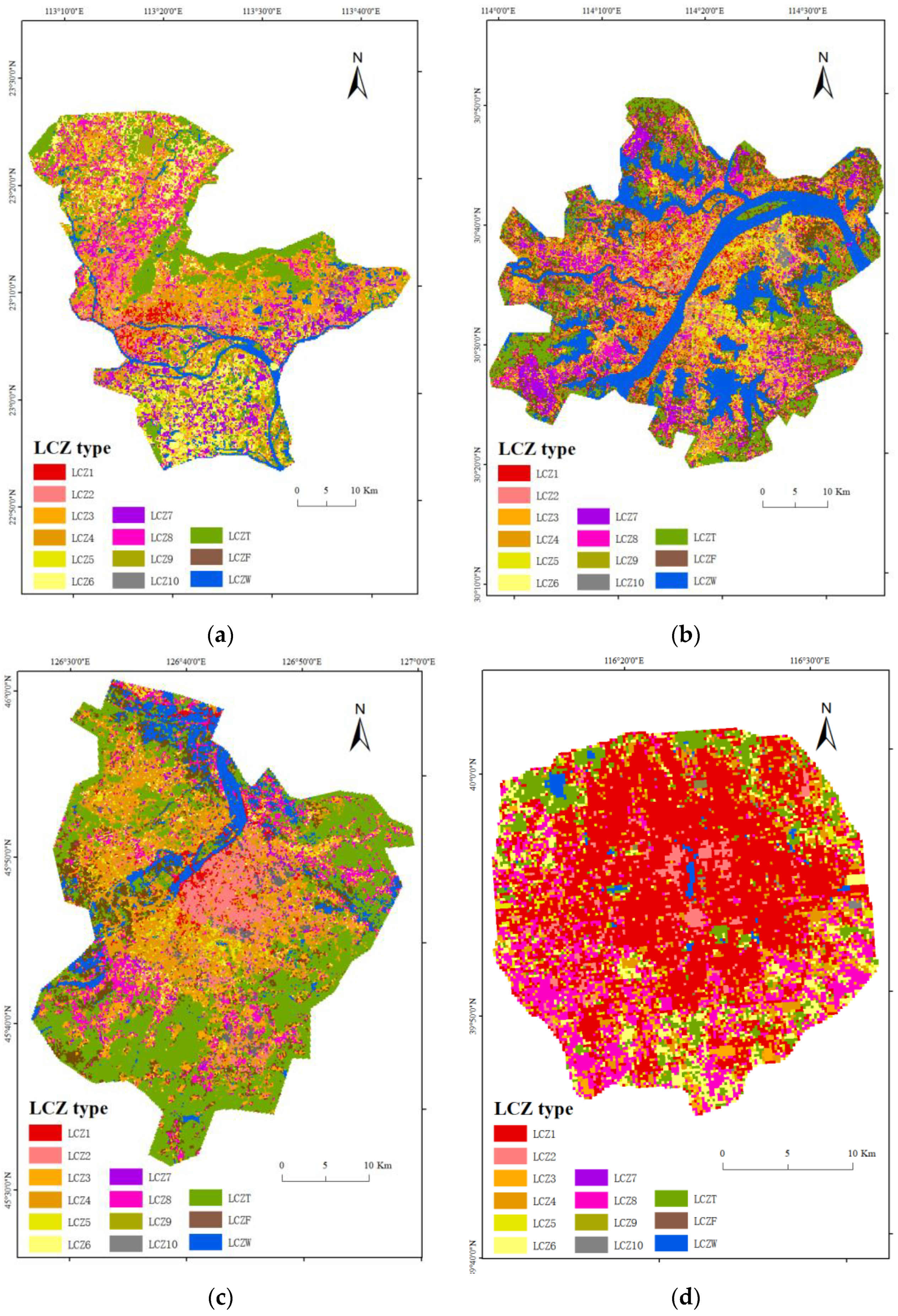
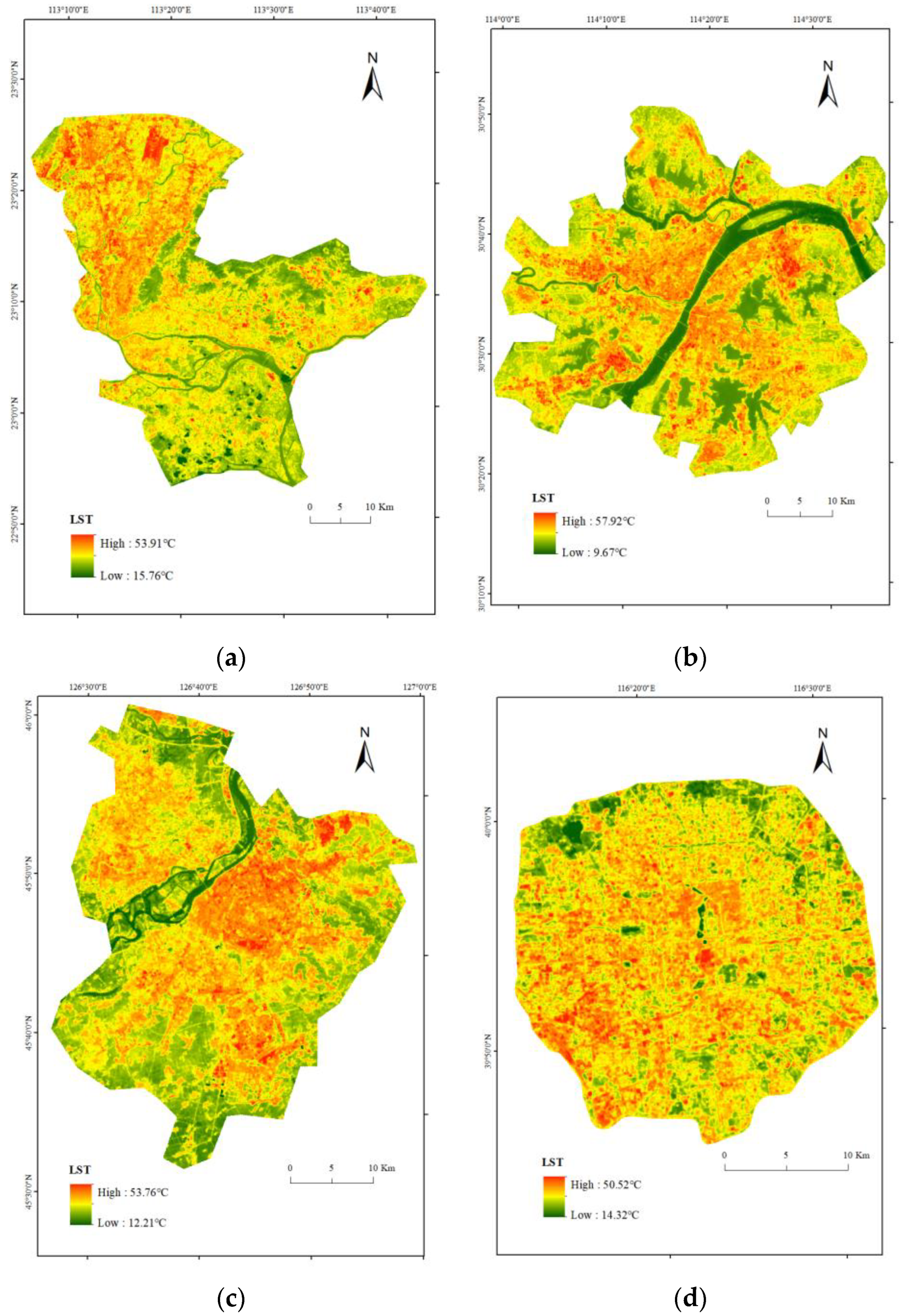

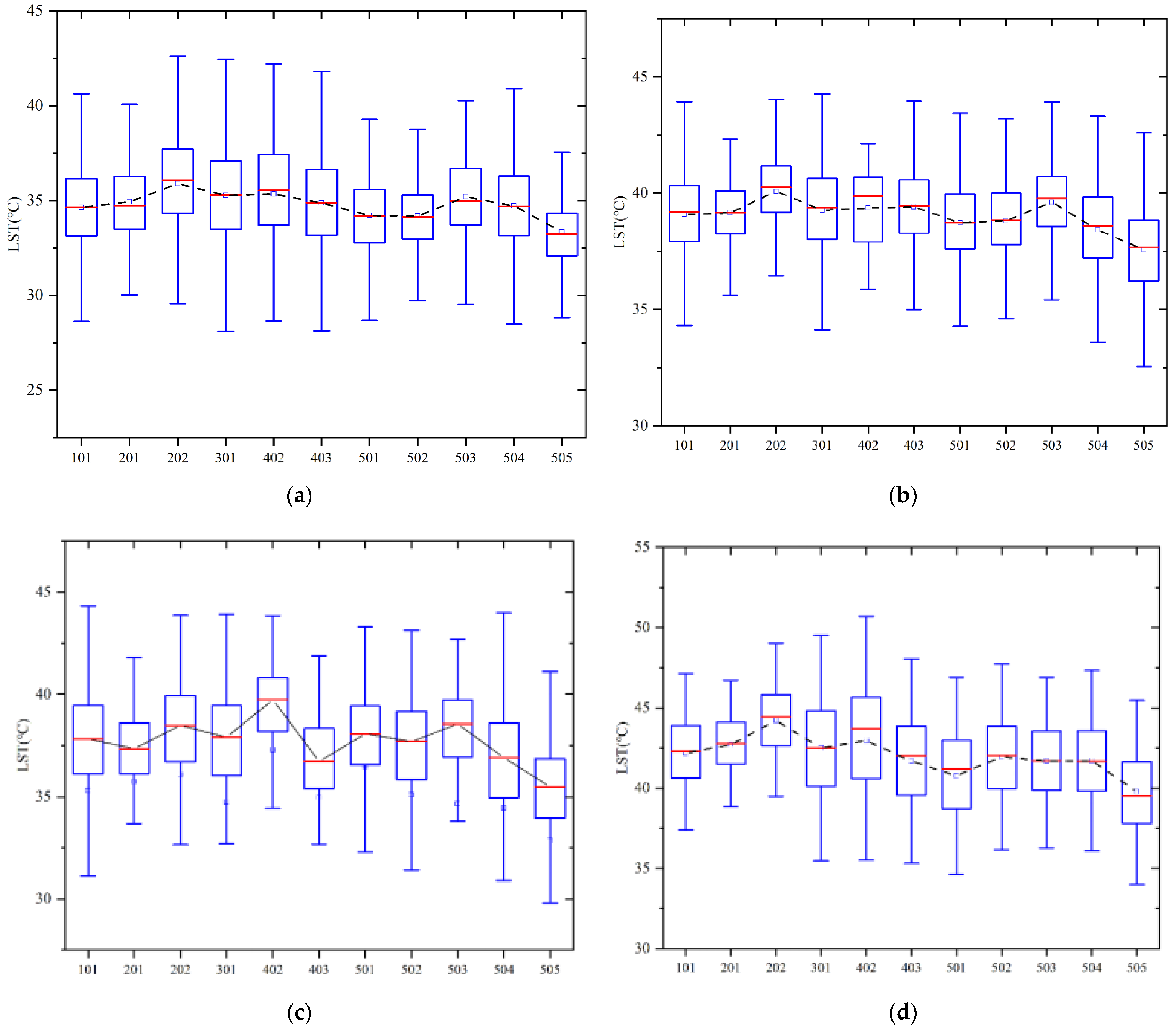
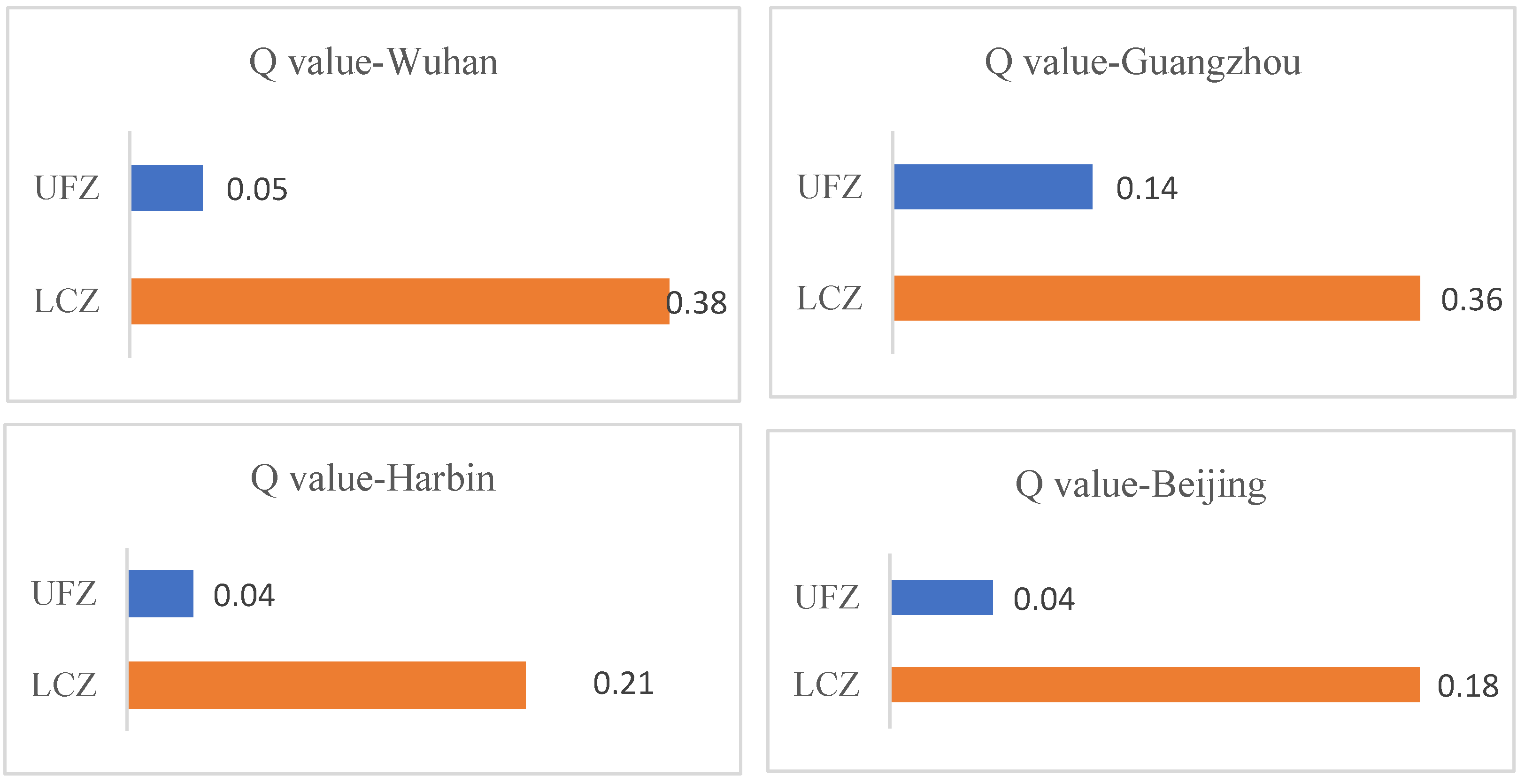
| Data Type | Detailed Information | |||
|---|---|---|---|---|
| Raster data | Data name | Region | Time | Row and path number |
| Landsat8 image data | Beijing | 17 August 2019 | 123 32 | |
| Harbin | 7 July 2017 | 118 28 | ||
| Wuhan | 23 July 2016 | 123 39 | ||
| Guangzhou | 20 August 2017 | 122 44 | ||
| Vector data | Data name | Data source | ||
| UFZ data | http://data.starcloud.pcl.ac.cn/ (accessed on 18 August 2023, Tsinghua University Public Data Set) | |||
| Built-up area data | http://data.starcloud.pcl.ac.cn/ (accessed on 18 August 2023) | |||
| Building base data | http://data.tpdc.ac.cn (accessed on 18 August 2023) | |||
| UFZ | Guangzhou | Wuhan | Harbin | Beijing | ||||||||
|---|---|---|---|---|---|---|---|---|---|---|---|---|
| LCZ with High Correlation | Support | Confidence | LCZ with High Correlation | Support | Confidence | LCZ with High Correlation | Support | Confidence | LCZ with High Correlation | Support | Confidence | |
| 101 Residential zone | LCZ2 Compact mid-rise | 0.172 | 0.220 | LCZ5 Open mid-rise | 0.228 | 0.417 | LCZ2Compact mid-rise | 0.124 | 0.297 | |||
| 201 Commercial office zone | LCZ1 Compact high-rise | 0.105 | 0.299 | LCZ2 Compact mid-rise | 0.173 | 0.293 | LCZ2 Compact mid-rise | 0.314 | 0.647 | |||
| LCZ2 Compact mid-rise | 0.173 | 0.210 | LCZ5 Open middle-rise | 0.230 | 0.198 | |||||||
| 202 Business service zone | LCZ2 Compact mid-rise | 0.174 | 0.543 | LCZ3Compact low-rise | 0.214 | 0.225 | LCZ1 Compact high-rise | 0.105 | 0.325 | LCZ1 Compact high-rise | 0.144 | 0.671 |
| LCZ8 Large low-rise | 0.146 | 0.153 | LCZ2 Compact mid-rise | 0.362 | 0.718 | |||||||
| 301 Industrial zone | LCZ8 Large low-rise | 0.148 | 0.224 | LCZ7Lightweight low-rise | 0.108 | 0.269 | LCZ3 Compact low-rise | 0.101 | 0.256 | LCZ3 Compact low-rise | 0.129 | 0.152 |
| LCZ4 Open high-rise | 0.151 | 0.322 | LCZ8 Large low-rise | 0.169 | 0.333 | |||||||
| 402 Transport station | LCZ8 Large low-rise | 0.165 | 0.273 | |||||||||
| LCZ9 sparsely built | 0.110 | 0.182 | ||||||||||
| 403 Airport facilities | LCZ9 Sparsely built | 0.132 | 0.500 | |||||||||
| 501 Administrative zone | LCZ4 Open high-rise | 0.120 | 0.420 | LCZ5 Open mid-rise | 0.166 | 0.429 | LCZ5 Open mid-rise | 0.317 | 0.750 | LCZ1 Compact high-rise | 0.428 | 0.913 |
| 502 Education zone | LCZ4 Open high-rise | 0.154 | 0.576 | LCZ2 Compact mid-rise | 0.101 | 0.186 | LCZ2 Compact mid-rise | 0.106 | 0.462 | LCZ1 Compact high-rise | 0.345 | 0.724 |
| LCZ5 Open middle-rise | 0.253 | 0.464 | LCZ9 Sparsely built | 0.132 | 0.429 | LCZ4 Open high-rise | 0.127 | 0.157 | ||||
| 503 Medical zone | LCZ2 Compact middle-rise | 0.100 | 0.340 | LCZ2 Compact mid-rise | 0.115 | 0.308 | LCZ2 Compact mid-rise | 0.489 | 0.838 | LCZ1 Compact high-rise | 0.462 | 0.920 |
| LCZ2 Compact mid-rise | 0.140 | 0.163 | ||||||||||
| 504 Sports and cultural | LCZ6 Open low-rise | 0.255 | 0.163 | LCZ9 Sparsely built | 0.111 | 0.364 | ||||||
| 505 Parks and green | LCZT Trees and plants | 0.364 | 0.509 | LCZT Trees and plants | 0.151 | 0.329 | LCZ6 Open low-rise | 0.150 | 0.491 | LCZW Water | 0.241 | 0.354 |
| LCZT Trees and plants | 0.445 | 0.650 | ||||||||||
| LCZW Water | 0.352 | 0.455 | ||||||||||
| LCZ | Guangzhou | Wuhan | Harbin | Beijing | ||||||||
|---|---|---|---|---|---|---|---|---|---|---|---|---|
| UFZ with High Correlation | Support | Confidence | UFZ with High Correlation | Support | Confidence | UFZ with High Correlation | Support | Confidence | UFZ with High Correlation | Support | Confidence | |
| LCZ1 Compact high-rise | 502 Education zones | 0.206 | 0.395 | 101 Residential zones | 0.105 | 0.519 | ||||||
| LCZ2 Compact mid-rise | 503 Medical zones | 0.102 | 0.475 | 101 Residential zones | 0.151 | 0.557 | 502 Education zones | 0.212 | 0.356 | 101 Residential zones | 0.126 | 0.696 |
| LCZ3 Compact low-rise | 301 Industrial zones | 0.178 | 0.402 | 202 Business service zones | 0.237 | 0.587 | ||||||
| LCZ4 Open high-rise | 201 Commercial office zones | 0.189 | 0.320 | |||||||||
| LCZ5 Open mid-rise | 101 Residential zones | 0.108 | 0.281 | 504 Sports and cultural | 0.110 | 0.433 | 101 Residential zones | 0.187 | 0.415 | 502 Education zones | 0.229 | 0.368 |
| LCZ6 Open low-rise | 301 Industrial zones | 0.270 | 0.466 | 101 Residential zones | 0.241 | 0.530 | 101 Residential zones | 0.127 | 0.274 | 403 Airport facilities | 0.257 | 0.643 |
| 403 Airport facilities | 0.135 | 0.233 | 504 Sports and cultural areas | 0.120 | 0.553 | |||||||
| LCZ7 Lightweight low-rise | 301 Industrial zones | 0.237 | 0.489 | |||||||||
| LCZ8 Large low-rise | 504 Sports and cultural | 0.349 | 0.596 | 403 Airport facilities | 0.144 | 0.780 | ||||||
| LCZ9 Sparsely built | 403 Airport facilities | 0.176 | 0.651 | 403 Airport facilities | 0.621 | 0.840 | ||||||
| LCZ10 Heavy industry | 301 Industrial zones | 0.403 | 0.760 | 301 Industrial zones | 0.208 | 0.632 | ||||||
| LCZT Trees and plants | 505 Parks and green areas | 0.105 | 0.193 | 101 Residential zones | 0.116 | 0.277 | 101 Residential zones | 0.111 | 0.333 | |||
| 505 Parks and green areas | 0.455 | 0.520 | 505 Parks and green areas | 0.306 | 0.211 | |||||||
| LCZW Water | 504 Sports and cultural areas | 0.127 | 0.200 | |||||||||
Disclaimer/Publisher’s Note: The statements, opinions and data contained in all publications are solely those of the individual author(s) and contributor(s) and not of MDPI and/or the editor(s). MDPI and/or the editor(s) disclaim responsibility for any injury to people or property resulting from any ideas, methods, instructions or products referred to in the content. |
© 2023 by the authors. Licensee MDPI, Basel, Switzerland. This article is an open access article distributed under the terms and conditions of the Creative Commons Attribution (CC BY) license (https://creativecommons.org/licenses/by/4.0/).
Share and Cite
Xu, Y.; Hou, W.; Zhang, C. Spatial Association Rules and Thermal Environment Differentiation Evaluation of Local Climate Zone and Urban Functional Zone. Land 2023, 12, 1701. https://doi.org/10.3390/land12091701
Xu Y, Hou W, Zhang C. Spatial Association Rules and Thermal Environment Differentiation Evaluation of Local Climate Zone and Urban Functional Zone. Land. 2023; 12(9):1701. https://doi.org/10.3390/land12091701
Chicago/Turabian StyleXu, Yinuo, Wei Hou, and Chunxiao Zhang. 2023. "Spatial Association Rules and Thermal Environment Differentiation Evaluation of Local Climate Zone and Urban Functional Zone" Land 12, no. 9: 1701. https://doi.org/10.3390/land12091701





